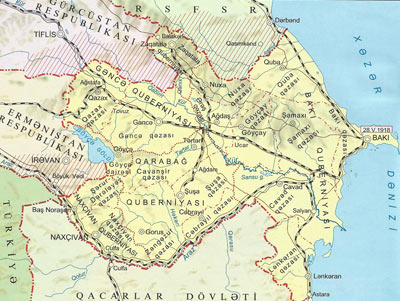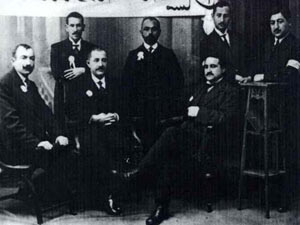Home page
» HISTORY
» States of Azerbaijan
» Democratic Republic of Azerbaijan
Democratic Republic of Azerbaijan Azerbaijan Democratic Republic)
(May 1918 - April 1920)
The most terrible and bloody military-feudal colonial regime in the history of humanity -Tsarist Russia could not destroy the statehood traditions of the Azerbaijani people. Russian empire that conducted the policy to destroy the ancient traditions and national self-esteem consciousness of the Turkish-Muslim peoples under the oppression of had turned the South Caucasus to the most terrible arena of bloody massacre. The purpose of this cruel policy was ‘’cleansing” of Turkish-Muslim population of Azerbaijan in South Caucasus, then defeat Iran and Turkey and open ways to warm seas, so to achieve the historical Russian desire - to reach India. Therefore, Azerbaijan became the arena of the most terrible trial of the national-colonial policy of tsarist Russia. Under such conditions in the territory of the entire Russian Empire, Azerbaijan, which has ancient statehood traditions, became the main center of national resistance movement against the cruel national-colonial regime of tsarism. The people of Azerbaijan, which accustomed not to be governed but govern, under the leadership of its leading intellectuals led the Turkish-Muslim peoples of the whole of Russia in front of a national liberation movement.
On May 28, under the chairmanship of Hasan bey Agayev the historical assembly of the National Council of Azerbaijan was held.
Those who participated in the meeting, Hasan bey Agayev (chairman), Mustafa Mahmudov (Secretary), Fatali Khan Khoyski, Khalil Bey Khasmammadov, Nasib bey Usubbəyov, Mir Hidayat Seyidov, Nariman bay Narimanbeyov, Heybet Gulu Mammadbayov, Mehdi Bey Hajinsky, Ali Asker Mahmudbeyov, Aslan bey Qardasov, Sultan Majid Ganizade, Akbar Agha Sheykhulislamov, Mehdi Bey Hacıbababeyov, Mamed Yusif Jafarov, Xudadat bey Malik-Aslanov, Rahim bey Vekilov, Hamid Bey Shakhtakhtinski, Firidun bay Kocherlinski, Jamo Hajinsky, Shafi bay Rustambeyov, Khosrov Pasha bey Sultanov, Jafar Akhundov, Mohammed Maharramovl, Javad Malik-Yeganov and Haji Molla Salim Akhundzadeh had adopted DECLARATION OF INDEPENDENCE of Azerbaijan.
 Declaration of Independence of the Turkic-Muslim world, in general, in the entire East, informed about the democratic republic in Azerbaijan for the first time, the creation of parliamentary republic. It was stated in the Declaration of Independence of National Council:
1. Beginning from today, as people of Azerbaijan have the power, Azerbaijan that covers the South-Eastern Transcaucasia, is a full-fledged independent state.
3. Azerbaijan Democratic Republic is going to establish kind friendly relations with all the nations, in particular, with the neighboring nations and states.
4. Azerbaijan Democratic Republic regardless of nationality, religion, class, gender provides all the citizens living within its borders the political rights and citizenship right.
5. Azerbaijan Democratic Republic creates wider opportunities within its territory for all nations for free development.
After Yerevan city and provincial areas were made on concession, the territory of Azerbaijan Democratic Republic on May 28, 1918, at date of declaration of independence was 99908.86 km ².
After the concession made the territory of Azerbaijan was 8913.17 km ². After this concession the Armenians began to claim for Nakhichevan, Zangezur and Nagorno-Karabakh territories. But during 1918-1920, the Armenians that could not seize other areas except the province of Yerevan can capture new territories under the patronage of Bolsheviks after April 28, 1920, occupation of Azerbaijan by Soviet Russia.
On May 30, 1918 radio telegrams were sent to world’s states on the creation of the Democratic Republic of Azerbaijan. The ministries of foreign affairs of the world\'s leading states received the information on creation of an independent state. Radio telegrams were sent to Istanbul, Berlin, Vienna, Paris, London, Rome, Washington, Sofia, Bucharest, Tehran, Madrid, Moscow, Stockholm, Tokyo and other capitals.
As Baku city was under control of Bolshevik Baku Soviet and Dashnak armed forces under the leadership of Shaumyan the government of Azerbaijan had been temporarily located in Ganja city.
As result of negotiations held on June 4, 1918 in Batum treaty on peace and friendship” was signed between Democratic Republic of Azerbaijan and the Ottoman Empire. The treaty was signed on behalf of the Azerbaijan by Chairman of the National Council M. Rasulzade and Minister of Foreign Affairs M. Hajinsky, from the Ottoman side Minister of Justice Khalil Bey and commander of the Caucasian front Vahab Pasha. By this treaty the Democratic Republic was first recognized by the Ottoman Empire. In the contract the Ottoman Empire committed to provide military assistance to the People\'s Republic.
On June 17, 1918 when the National Council of Azerbaijan had its first meeting in view of grave situation in the country had decided to suspend its activities, and to hand over all the power (legislative and executive) to the Council of Ministers until the new parliament (Milli Majlis) was elected. This was the request of the Nuri Pasha. On the same day the Council of Ministers headed by Fatali Khan Khoyski resigned and the second government was formed under his leadership.
On June 24, 1918 the first flag of the Azerbaijan Democratic Republic was adopted. By the decision of the Government red cloth with a white crescent and eight-pointed star on the flag was declared as a symbol of the Republic temporarily. The current three-color (blue, red, green) state flag of Azerbaijan was adopted in November 1918 as a symbol of the state.
On June 26, 1918 the Government of the People\'s Republic made a decision on the establishment of separate division, the first unit of the National Army. At that time, the military forces, which were subordinated to the government of the republic together with Turkish (Ottoman) military units (the Caucasian Islamic Army), under the command of Nuri Pasha had fierce battles with forces of Baku commune. The decision on organization of the Ministry of Defense of the Republic was adopted later on August 1. The ministry self began activity in December 1918. One of the generals of former Russian tsarist army, Samad bey Mehmandarov was appointed as Defense Minister and Ali Agha Shikhlinskias Deputy Minister.
On June 27, 1918 - the Caucasian Islamic Army Azerbaijani and Turkish (Ottoman), consisting of military forces defeated troops of Baku Soviet in battle near Goychay. After this victory units of the Caucasus Islamic Army stopped attacks of Dashnak-Bolshevik troops and began counter-attacks.
On June 27, 1918 - the Government of the People\'s Republic made a decision On State language. Azeri (Turkic) language has been declared the state language in the territory of the Republic.
On July 2, 1918 - the chairman of the Council of Ministers and Minister of Internal Affairs of the Democratic Republic Fatali Khan Khoyski had ordered on establish the first police department in the country. By it the foundation of the police authorities was laid.
On July 10, 1918 - Azerbaijani and Turkish (Ottoman) forces (the Caucasian Islamic Army) in the battle near Kurdamir had defeated Dashnak-Bolshevik Baku Council troops. Kurdamir settlement was liberated from occupants. After this victory the Caucasian Islamic Army launched a counter-attack on Dashnak-Bolshevik forces. On July 14, the Azerbaijani-Turkish troops have seized the strategically important Karar railway station.
On July 15, 1918 - the government of Democratic Republic had set the Extraordinary Investigation Commission to investigate crimes of genocide against the Azerbaijanis. The Commission besides March 1918 massacres had collected a lot materials on other massacres committed by Armenians against Azerbaijanis from the beginning of the twentieth century, and by the decision of the Government of the Republic March 31 was declared as Genocide Day. After Sovietization of Azerbaijan this date was hidden.
On July 20, 1918 - forces of People\'s Democratic Republic and the Turkish (Ottoman), the Caucasian Islamic Army under the command of Nuri Pasha once made a blow on Dashnak-Bolshevik Baku Commune troops and so liberated city of Shamakhy.
On July 20, 1918 the Turkish and Azerbaijani troops under the command of Nuru Pasha began to forward on direction of Baku from the south (now Neftchala area).
On September 6, 1918 - A delegation of the Democratic Republic met in Istanbul with the leadership of Ottoman state. Delegation included Chairman of the Council M. Rasulzade, member of Musavat fraction Kh.Khasmamedov and general S. Safikurdski was received by the new Ottoman sultan Mehmet VI. It was the first foreign official visit of the official delegation of People’s Republic. At the meeting participated by Ottoman military leadership (Enver Pasha), the matter of military aid to the People\'s Republic and liberation of Baku was the main topic. After this meeting a decision on decisive attack on the liberation of Baku city was taken.
After heavy fights on September 15, 1918, the units of national army of Azerbaijan Democratic Republic and the Ottoman Turkish Islamic army led by Nuru Pasha had liberties Baku from Bolshevik, Armenian, and English military units and independent government of Azerbaijan has moved to Baku.
On May 28, 1919 - The Azerbaijani delegation led by Alimardan bay Topcubashov in Paris peace conference, met with U.S. President Woodrow Willson and asked to recognize the People\'s Republic. But Wilson rejected this request as being known as in Antiturk and pro-Armenian position.
On June 16, 1919 - a military alliance pact signed between Azerbaijan and Georgia. According to the pact, Azerbaijan gave oil to the Georgian side and in exchange gat for weapons and equipment. According to the Military pact, the parties were obliged to support each other against the Russian military aggression. However, in April 1920 during the Bolshevik invasion of Russia, Georgia preferred not oblige this pact but to go on separate negotiations with Russians to recognize its independence.
|
